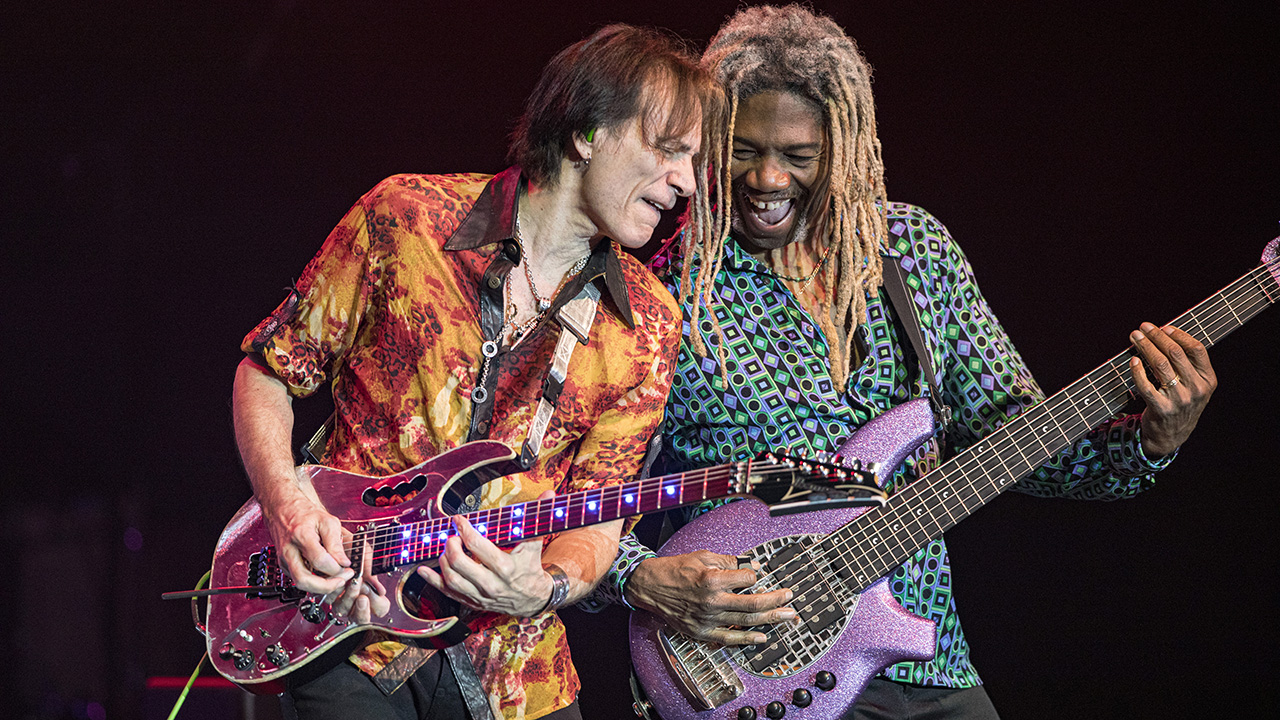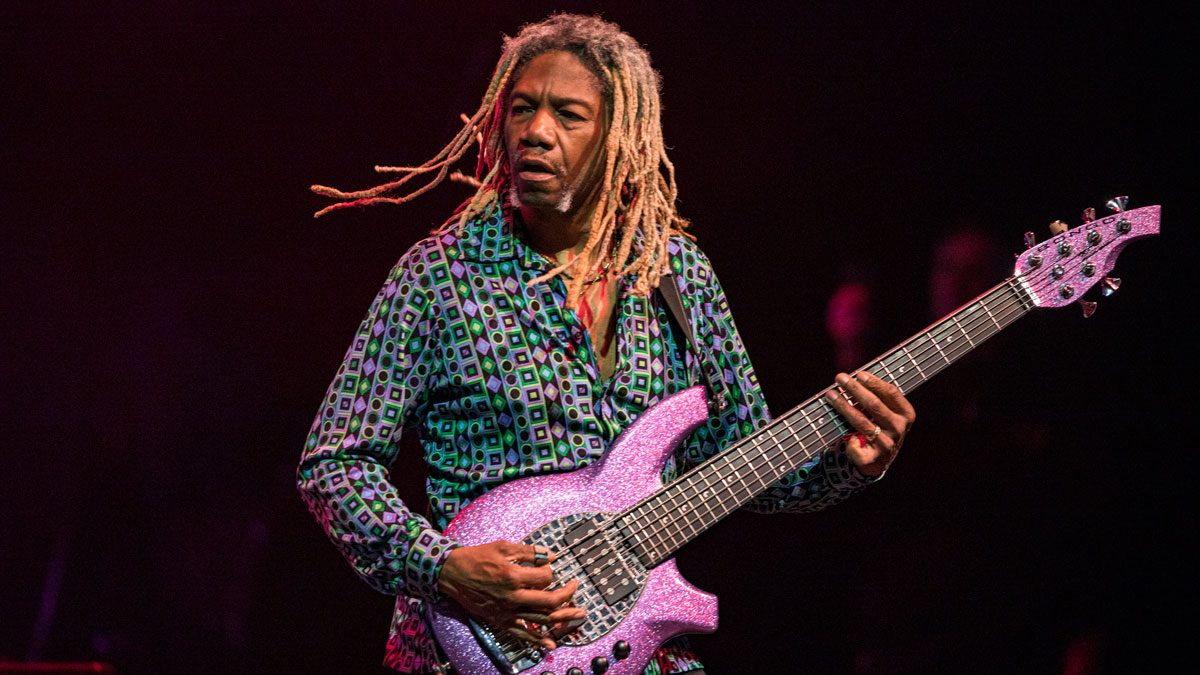“Steve Vai is always evolving… he continues to achieve what others thought impossible, and he finds new things to try every day”: How Philip Bynoe keeps up with the world-leading virtuoso
The Berklee grad on what drew him to six-string basses over fours and fives, why sometimes it’s important to compromise on tone, and modern playing techniques versus the joy of “a simple melody you can’t stop humming”

It can’t be easy holding down the low end alongside Steve Vai, an iconic virtuoso possessing incomprehensible skill. And yet, from 1996 through 2000 and since 2012, Philip Bynoe has done just that.
The road is one thing, but Bynoe – who scored the Vai gig via his friendship with former Dream Theater drummer Mike Mangini – has also appeared on four of Vai’s studio offerings, along with several live albums.
With three Grammy nominations and an Emmy Award for his work on the soundtrack for the remake of Reefer Madness, the Berklee alum is one of the smoothest in the business. “My advice to all young musicians is take care of yourself and eat good food,” Bynoe tells Bass Player. “A career in music is a long road.
“I didn’t get into Steve’s band until I was 34. Yes, I partied – but when you get older you have to take care, so that when you have your shot you can reach for the stars.”
What inspired you to pick up bass, and what keeps you inspired?
“I was inspired by family. My dad was an upright bassist and my mom played cello. My brother was in a band in the ‘70s and went on the road straight out of high school. What keeps me playing is the love of music and performing. It’s been with me since I was six or seven years old, and as long as I’m standing I hope to continue playing.”
What type of scene did you grow up in?
Get The Pick Newsletter
All the latest guitar news, interviews, lessons, reviews, deals and more, direct to your inbox!
“My father played in the symphony, so I grew up listening to that with him. I also had three older sisters, so I heard all the Motown hits of the day. Learning those songs and listening to symphony music really was key to opening my ears to many possible ways to create and perform music.”
What did your first proper bass rig look like?
“The first rig I had was my father’s Realistic bass and amp from Radio Shack. When I’d saved up some money I bought a Fender Jazz bass and then an SVT amplifier. There were one or two others along the way, but that was the first rig that made me feel like a pro.”
How did you get the gig with Steve Vai?
“I was introduced to Steve by my friend Mike Mangini; he and I played together in bands in Boston in the ‘80s. Michael told him about me, and Steve trusted him, and I got to audition.
“The audition was good. I had learned most of Steve’s catalog with Mike as he was going to do the tour, and since we were friends, I learned the songs so we could play together. And then I played Kill the Guy with the Ball, and we jammed for a bit.”
What’s the key to locking in with Steve?
“I approach it this way: Steve is a masterful musician, and his rhythm chops are unmatched. So, we all lock to the drums, and the drummer plays with a click. I listen to what everyone is doing and try to support them both musically and rhythmically.”
Does Steve have preferences in terms of what gear you use?
“When I started with him, he had some very specific preferences about tone and things. Now I have a better understanding of what he wants and I’ve managed to change my tone. So it’s some of what I like and also what he likes, to create a happy medium.
“We worked together on it – he has a wonderful grasp on how to use EQ, so he showed me points on my rig, and ways to use EQ to get the sound he wanted.
“Over the years, I’ve worked with the front of house and discovered ways to make my bass sound the way I like, as well as adjusting things to make my bass sound great in the venue.”
What’s a nuance of Steve’s that people miss?
Going across the fretboard instead of up and down the neck makes watching a conductor or looking for cues easier
“Tough question! I believe we touch on all styles of music and his fans hear everything he can think of – it’s always evolving. He continues to grow as a man and a musician. You’d have to ask him about his philosophy, but I will say that he continues to achieve what others thought was not possible, and he finds new things to try every day.”
What’s the most inspiring thing about playing with Steve?
“Many of the songs are favorites for different reasons. Some are about what [drummer] Jeremy Colson and I are doing together as a rhythm section. But what’s challenging is learning to be in the moment with the music.
“Being a part of the music is also what is inspiring to me. It’s about making the audience feel something. If you can move someone, especially if they weren’t expecting it, that’s a real moment.”
Since you play alongside one of the era’s preeminent soloists, how do you view guitar solos in the modern era?
“Everything is going faster and faster. The technical abilities of the younger musicians coming out now are breathtaking. I do sometimes miss hearing a simple melody played with feeling – just something you can’t stop humming. That’s when you’ve got something.
“I think as time goes by and there’s more information about how to play, the players just get better. If you compare what rock ’n’ roll was in the ‘70s to what it is now, you come to the same conclusion. In 20 years, this music might seem like old blues songs compared to where it could be by then.”
What gear are you currently using, and what’s the secret to your tone?
“I use Music Man Bongo basses – they have a great feel to them. They are the lightest six-string basses I’ve found, and their design suits how I play. And I think they’re great-looking instruments!
“I’m using Aguilar amplifiers and the Helix from Line 6. But on this last touring cycle, I left my amp at home, played through my Helix, and used in-ear monitors for my sound. It took a little getting used to, but all the sound people love it.”
Why do you like the Helix?
“It has helped us all bring our stage volume down – which, of course, makes the band easier to mix. It’s so fast for programming, and the basses are a perfect balance of great tone and the ability to be aggressive when needed. There are many great new basses out there, but for now, the only new gear I buy is for recording at home in my studio.”
What drew you to the six-string bass over four or five strings?
“I started playing six-string when I was doing a lot of sight-reading gigs. When you’re doing musical theater pit shows or church services, you have to walk in and go.
Gearheads are always buying gear; when you find something that works for you, you shouldn’t need anything else
“Being able to go across the fretboard instead of up and down the neck makes watching a conductor or looking for cues easier because you can stay in position.”
Does Steve’s music often call for that?
“Sometimes there might be a spot where I need to play harmony to a line in a song. If I were playing a five-string I’d use an octave-up pedal, but with the C string on top, I can grab the phrase and continue without having to jump on a pedal.
“Also, in other situations, like a power trio, I can play some interesting chords to support a soloist while still maintaining the bass part.”

How would you compare how you play today versus the past?
“When I was young, I was very much into slap bass. Now I’m more interested in playing for the song or composition first. I like to create bass parts that are exactly what a song needs. As I evolve as a musician, my tone does as well.
“I plot my bass tone depending on the project. If I’m doing a metal show or a Motown or dance show, I’ll play bass tones and make choices that will support the project or artist. I try to keep my ear on where bass is going.”
What advice would you give to gearheads?
“I endorse the companies I’ve mentioned, so for me, that’s the best stuff. But gearheads are always buying gear; I think when you find something that works for you, then you shouldn’t need anything else.”
Tube amp versus solid-state: where do your allegiances lie?
“If I have to carry it, I’m going with the solid-state amp. They tend to be lighter, and since it’s really just a stage monitor, why make it too big?
“Tube amps are great, and there’s something to be said for that warmth – but I’d rather have my bass in the PA than try to compete with the people on stage.”
What are your short and longterm goals?
“The short term is to continue working and creating music with anyone I have a chance with. As an independent contractor, I explore all opportunities to keep my name in players’ minds so I can continue to work.
“The long term is about being healthy. If you’re healthy, you can be good and feel good. Grinding on the road with Steve, sometimes we’ll play many shows in a row – but the joy of performing makes everything great, especially when you feel good.”
Andrew Daly is an iced-coffee-addicted, oddball Telecaster-playing, alfredo pasta-loving journalist from Long Island, NY, who, in addition to being a contributing writer for Guitar World, scribes for Bass Player, Guitar Player, Guitarist, and MusicRadar. Andrew has interviewed favorites like Ace Frehley, Johnny Marr, Vito Bratta, Bruce Kulick, Joe Perry, Brad Whitford, Tom Morello, Rich Robinson, and Paul Stanley, while his all-time favorite (rhythm player), Keith Richards, continues to elude him.
“His songs are timeless, you can’t tell if they were written in the 1400s or now”: Michael Hurley, guitarist and singer/songwriter known as the ‘Godfather of freak folk,’ dies at 83
“The future is pretty bright”: Norman's Rare Guitars has unearthed another future blues great – and the 15-year-old guitar star has already jammed with Michael Lemmo











